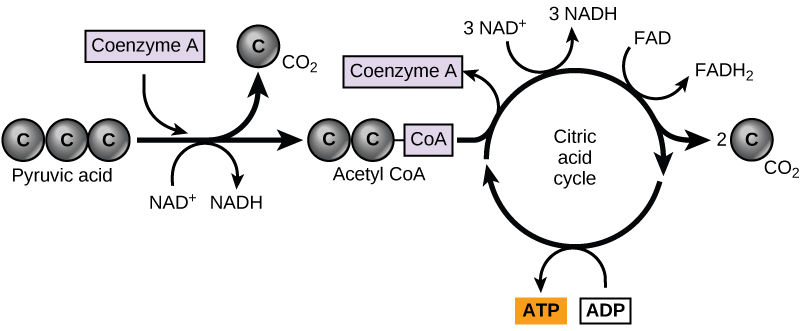| << Chapter < Page | Chapter >> Page > |
In eukaryotic cells, the pyruvate molecules produced at the end of glycolysis are transported into mitochondria, which are sites of cellular respiration. If oxygen is available, aerobic respiration will go forward. In mitochondria, pyruvate will be transformed into a two-carbon acetyl group (by removing a molecule of carbon dioxide) that will be picked up by a carrier compound called coenzyme A (CoA), which is made from vitamin B. The resulting compound is called acetyl CoA . ( [link] ). This set of reactions is referred to as the transition reaction, as it happens during pyruvate transport into the mitochondria. The major function of acetyl CoA is to deliver the acetyl group (2 carbon fragment) derived from pyruvate to the next pathway in glucose catabolism, which is the citric acid/Kreb's cycle. Note that during the transition reaction, each pyruvate/pyruvic acid molecule loses one carbon as carbon dioxide and one molecule of NADH is produced. Therefore, a total of two molecules of carbon dioxide and two molecules of NADH are produced per glucose that started glycolysis.

Like the conversion of pyruvate to acetyl CoA, the citric acid cycle (also called the Kreb's cycle) in eukaryotic cells takes place in the matrix of the mitochondria. Unlike glycolysis, the citric acid cycle is a closed loop: The last part of the pathway regenerates the compound used in the first step. The eight steps of the cycle are a series of chemical reactions that produces two carbon dioxide molecules, one ATP molecule (or an equivalent), and reduced forms (NADH and FADH 2 ) of NAD + and FAD + , important coenzymes in the cell. Part of this is considered an aerobic pathway (oxygen-requiring) because the NADH and FADH 2 produced must transfer their electrons to the next pathway in the system, which will use oxygen. If oxygen is not present, this transfer does not occur. Note that per glucose that started glycolysis, processing of the two pyruvate/pyruvic acid molecules in the citric acid cycle will result in the production of a total of six NADH, two FADH 2 , and two ATP. Also note that at this point, a total of six molecules of carbon dioxide have been released, which accounts for the six carbons in the starting glucose molecule. The high-energy NADH and FADH 2 will be used in the last stage of aerobic respiration to produce additional ATP molecules.
You have just read about two pathways in glucose catabolism—glycolysis and the citric acid cycle—that generate ATP. Most of the ATP generated during the aerobic catabolism of glucose, however, is not generated directly from these pathways. Rather, it derives from a process that begins with passing electrons through a series of chemical reactions to a final electron acceptor, oxygen. These reactions take place in specialized protein complexes located in the inner membrane of the mitochondria. The energy of the electrons is harvested and used to generate a electrochemical gradient of hydrogen ions across the inner mitochondrial membrane. The potential energy of this gradient is used to generate ATP by providing the energy to add phosphate groups to ADP molecules. The entirety of this process is called oxidative phosphorylation , as oxygen is required as the terminal electron acceptor and phosphate groups are added to ADP molecules.

Notification Switch
Would you like to follow the 'Human biology' conversation and receive update notifications?